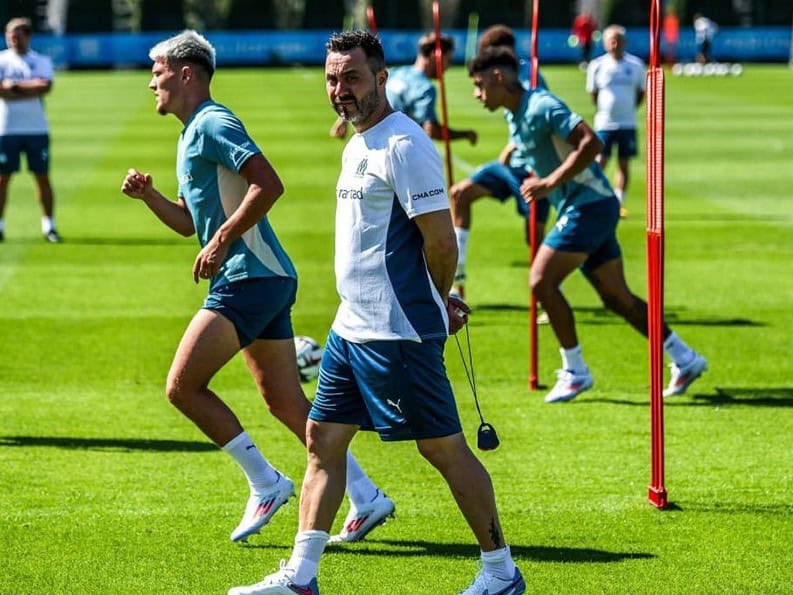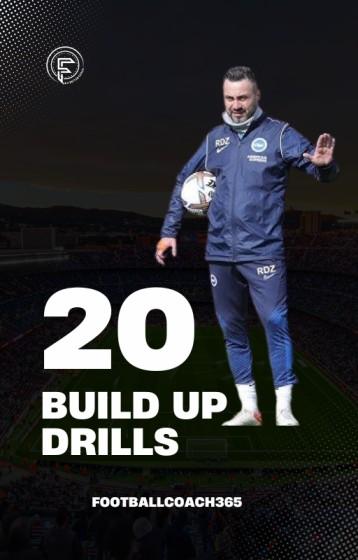Roberto De Zerbi has gained widespread recognition for his team’s ability to dominate possession and keep ball control of the game with structured build-up play. His philosophy is rooted in maintaining superior ball control, even under intense opposition pressure, and progressing play with precision.
For any soccer player, especially young players, developing ball control is an essential skill that can determine success on the field. A well-controlled first touch allows a player to evade pressing defenders, while precise passing ensures smooth team play.
Offensive players benefit from sharp touches that help them break through defensive lines, while defenders rely on composure and technique to keep possession under pressure. In major tournaments like the World Cup, teams with superior ball control often dictate the tempo, forcing opposition players to chase the game and struggle to win back possession.
If you want your team to improve ball control, develop composure under pressure, and efficiently transition from defense to attack, you need to focus on four key tactical elements from De Zerbi’s approach:
- Overloading the first line to create numerical superiority.
- Inviting pressure to create gaps behind.
- Providing near support to maintain short passing options.
- Utilizing the third man to break defensive structures.
Mastering these principles will enable your team to retain possession, play through pressure, and break down opponents efficiently. Let’s explore each element in detail.

Table of Contents
1. Overloading the First Line: Creating Numerical Superiority
One of De Zerbi’s key tactics to ensure ball control is overloading the first line of the opposition’s press. This involves having extra players drop deep to create a numerical advantage, typically by having a midfielder, full-back, or even the goalkeeper participate in the build-up.
Why This is Crucial for Ball Control
- More passing options: With additional players supporting from deep, the team always has multiple passing lanes, making it easier to keep possession and progress forward with more safety.
- Breaks down high press: If the opposition presses in a medium or high block aggressively, the overload makes it harder for them to find solutions and move the ball past the half line. Additionally, this allows the team to press more effectively in the event of a loss of possession.
- Invites the opponent to commit forward: This can create space higher up the pitch that can be exploited later.
How to Train This Concept
- Positional Build-Up Drills: Set up a 6v4 or 7 v 5 scenario where the attacking team has more players than the pressing attackers. Teach the back line and the midfielders to rotate positions and scan for passing options.
- Goalkeeper Involvement: Train your goalkeeper to act as an extra outfield player in build-up play. Encourage them to distribute calmly under pressure.
- Playing Out of the Back: Run controlled patterns where your team must progress past the first line of pressure before they can score. This reinforces patience and movement in deep areas.
By consistently practicing these elements, your team will learn to remain composed in possession, making it difficult for opponents to disrupt their rhythm.
2. Inviting Pressure to Create Gaps Behind
Rather than panicking when opponents press aggressively, De Zerbi’s teams intentionally invite pressure to force the opponents to get out of position. This opens up valuable space behind the pressing players, which can then be exploited with quick, precise passing.
Why This is Crucial for Ball Control
- Forces the opponent to commit players forward, opening up spaces between the lines.
- Encourages calmness under pressure, training players to make better decisions when pressed.
- Creates numerical advantages further up the pitch once the press is broken.
How to Train This Concept
- Rondo Under Pressure: Run small-sided rondo soccer drills in small or medium playing area, where the pressing team has a numerical advantage. The goal is to teach ball carriers to stay calm, use their body positioning wisely, and find escape passes.
- Breaking the Press Positional Play: Set up a soccer drill where defenders start by playing the ball out from the back while attackers press aggressively. Teach players to recognize when to play short and when to exploit space behind the pressing players.
- Split the Lines Drill: Organize a ball control drill, representing a game situation, where defenders and midfielders must play through an opponent’s high press using quick, short passes. Once the team plays through, they should look for a quick progressive pass into open space.
Below is an example of how inviting pressure can help a team break a compact defensive block. To use this principle, it’s important to understand whether the opponent actually intends to press and recover the ball. If they do want to press, the “attract pressure” concept can be used. If not, a different strategy is required: inviting or forcing the pressure, which is essentially the opposite. In this case, the attacking team dribbles toward the opponents to make them step out of their defensive positions. This will be discussed in more detail another time.
Here, we have a situation where the opponents form a compact 4-4-2 medium-to-low defensive block. There are no available spaces to play between or behind the defensive line, so there is a need to force them to open up their lines.
For many teams, a pass back is a pressing trigger, prompting them to jump out and press higher. Below, the left full-back (#3) passes back to the center-back (#4). Immediately, the attacking team’s players will make the pitch larger by backstepping.



The movement of the opponents to higher positions will eventually create spaces between their lines. Here, the attacking team, especially the back line, must identify the free players in order to pass to them directly or using the third-man concept.
Two possible options are to go through the central axis directly or to use a pass to the outside and then move inside.


By improving your team’s confidence under pressure, you ensure they maintain possession even in the most difficult situations.
3. Having Players for Near Support: Ensuring Passing Options
De Zerbi’s teams maintain exceptional ball control because they always have players positioned for near support. This means the ball carrier is never left isolated and always has short passing options to retain possession.
Why This is Crucial for Ball Control
- Reduces the chance of losing possession by keeping passing options close.
- Allows for quick ball circulation, making it harder for opponents to press effectively.
- Encourages fluid positional rotations, ensuring the team remains compact and connected.
How to Train This Concept
- Triangle Passing Drills: Set up triangle passing exercises where players must pass quickly and reposition themselves constantly.
- Tactical Positioning Games: Use 7v7 or 8v8 positional play exercises where every player must be within a specific distance of their nearest teammate to maintain compactness.
- One-Two Combination Drills: Practice quick one-two passing sequences between midfielders and defenders to emphasize movement and short passing options. Coaching points should emphasize on proper timing of the movements.
By training players to stay close and always provide passing lanes, your team will develop a structured build-up that is difficult to disrupt.

20 Build-Up Drills in Football is your go-to guide for learning how to play out from the back with confidence and control.
- Build Up Through the Zones
- Progress Through the Lines
- Attack Using Small-Sided Games
- Play Through the Central Channels
- Use a Double Pivot
- Build Up Against Different Defenses
- Inverted Full-Backs and Positional Rotations
- Adapt Your Formation
- Overcome Pressure
4. Utilizing the Third Man: Breaking Defensive Lines Efficiently
The third-man principle is one of the most powerful tools in De Zerbi’s build-up and possession play. Instead of passing directly to a teammate under pressure, players use a third player to bypass defenders and create space.
Why This is Crucial for Ball Control
- Ensures progressive ball movement without forcing risky passes.
- Allows players to receive the ball in forward-facing positions, making it easier to transition into attack.
- Breaks through compact defenses using quick passing combinations.
How to Train This Concept
- Three-Man Passing Drills: Set up a passing exercise where the ball must always go through a third player before progressing forward.
- Breaking Defensive Lines: Create a game scenario where defenders and midfielders must use a third man to bypass opposition pressure and advance into attacking zones.
- Positional Rotation Drills: Train players to recognize when to drop in as a third option, ensuring continuous movement and adaptability.
By consistently using the third-man concept, your team will be able to break down defensive structures while maintaining possession.
Final Thoughts: Mastering Ball Control Like De Zerbi
In modern soccer, ball control is an essential skill that separates top teams from the rest. Whether you are a defender building from the back or an offensive player looking to break through defensive lines, mastering technique under pressure is crucial.
Young players who develop their first touch and passing accuracy will find it easier to navigate tight spaces and outplay opposition players. The best teams in the World Cup consistently showcase superior ball control, using their composure and technical ability to dominate possession and dictate the rhythm of the game.
By implementing De Zerbi’s principles, your team can develop a structured and effective playing style that maximizes ball retention and exploits gaps in the opposition’s defense.
Roberto De Zerbi’s build-up and possession philosophy is based on patience, intelligence, and technical excellence. His teams retain possession not just for the sake of having the ball, but to control the rhythm of the game and manipulate the opposition.
Key Takeaways to Improve Ball Control
✅ Overload the first line to ensure numerical superiority and smoother build-up play.
✅ Invite pressure to create gaps behind the pressing line and exploit spaces.
✅ Provide near support so that players always have short, secure passing options.
✅ Use the third-man principle to break through defensive structures effectively.
By consistently training these concepts, your team will develop greater composure, improved passing accuracy, and the ability to control matches through possession.

